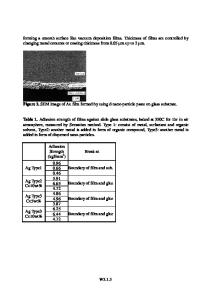Liquid–liquid extraction of oxide particles and application in supercapacitors
- PDF / 444,875 Bytes
- 9 Pages / 584.957 x 782.986 pts Page_size
- 29 Downloads / 826 Views
Mustafa S. Ata and Xinya Zhao Department of Materials Science and Engineering, McMaster University, Hamilton, Ontario, Canada L8S 4L7
Ishwar Puri Department of Mechanical Engineering, McMaster University, Hamilton, Ontario, Canada L8S 4L7; and Department of Materials Science and Engineering, McMaster University, Hamilton, Ontario, Canada L8S 4L7
Igor Zhitomirskya) Department of Materials Science and Engineering, McMaster University, Hamilton, Ontario, Canada L8S 4L7 (Received 8 December 2016; accepted 3 March 2017)
Many material manufacturing techniques require the use of nonaqueous colloidal suspensions, containing well dispersed oxide particles and various water insoluble functional components. We report an efficient method for the direct transfer of MnO2 and titania particles, synthesized in water, to an organic solvent through the interface of two immiscible liquids. Particle agglomeration during the drying stage was avoided, and stable suspensions of nonagglomerated particles in the organic phase were obtained. The benefits of this method were demonstrated by the fabrication of advanced composite MnO2-multiwalled carbon nanotube electrodes, containing a polymer binder, for electrochemical supercapacitors with high active mass loading and high active material to current collector mass ratio. The electrodes showed a capacitance of 5.13 F/cm2 and low impedance. High extraction efficiency from concentrated suspensions was achieved by the use of an advanced extractor, which allowed strong adsorption on the particles by the polydentate bonding. The extraction mechanism is discussed.
I. INTRODUCTION
Particle extraction through liquid–liquid interface (PELLI) is emerging as a new method of technological and scientific interest. PELLI has been utilized for the separation of rare earth fluorescent powders,1 alumina and zircon.2 Size-dependent transfer of gold particles allowed obtaining suspensions with narrow particle size distribution.3 PELLI has been utilized in the hydrometallurgy of cassiterite4 and other mineral particles.5 Luminescent CdTe and HgTe quantum dots, synthesized in an aqueous medium, were transferred to nonpolar organic solvents for the fabrication of photovoltaic and optoelectronic devices.6 Various organic molecules were used as extractors for PELLI applications. The chemical structures of such molecules contained hydrophobic hydrocarbon chains and functional groups, which provided electrostatic or chemical interactions with inorganic particles. Investigations were focused on the use of ionic surfactants,1–5 Contributing Editor: Eugene Medvedovski a) Address all correspondence to this author. e-mail: [email protected] DOI: 10.1557/jmr.2017.92
which had an electric charge, opposite to that of inorganic particles. In this case, the surfactant adsorption was governed by electrostatic interactions with inorganic particles. Ion-pair interactions of carboxylate-modified gold nanoparticles and cationic surfactants resulted in the particle transfer from water to toluene.7 The adsorption of other extractors,
Data Loading...











